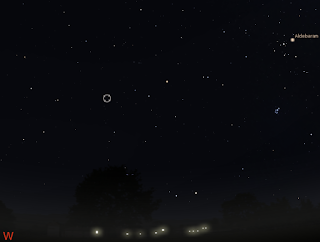Wednesday, January 31, 2018
The Sky This Week - Thursday February 1 to Thursday February 8
The Last Quarter Moon is Thursday, February 8.
Morning sky on Thursday February 1 looking east as seen from Adelaide at 5:31 ACDST (60 minutes before sunrise). Mars is very close to the star Beta1 Scorpii (Acrab). The inset shows a simulation of the field of view of a 30mm eyepieces with a 114mm Newtonian reflector telescope
Similar views will be seen throughout Australia at the equivalent local time (that is 60 minutes before sunrise, click to embiggen).
Simulated binocular view of Saturn as seen through 10x50 binoculars on Thursday February 1. The Lagoon nebula M24 and the globular cluster M22 are (roughly) within the field of view. Over the week Saturn will move slowly away from the Lagoon Nebula and closer to M22. Moonlight interference will decrease and the nebula will become clearer as the week goes on.
Similar views will be seen throughout Australia at the equivalent local time
Morning sky on Thursday February 8 looking east as seen from Adelaide at 5:33 ACDST (60 minutes before sunrise). Jupiter, Mars and Saturn form a line in the morning sky with the bright stars Antares and Spica (off the chart to the left). The Last Quarter Moon is close to Jupiter.
Similar views will be seen throughout Australia at the equivalent local time (that is 60 minutes before sunrise, click to embiggen).
Morning sky on Saturday February looking north as seen from Adelaide at midnight ACDST the asteroid Ceres is between the sickle of Leo and the bottom star of the constellation of Cancer, the crab.
Similar views will be seen throughout Australia at the equivalent local time (click to embiggen).
Black and white binocular chart suitable for printing (click to embiggen and print).
The large circle represents the field of view of 10x50 binoculars.
The asteroid 1 Ceres is relatively easily visible in binoculars until around the middle of this month, it fades during this time but interference from Moonlight is reduced by mid-month.
Ceres is relatively easy to find. It is above the northern horizon at midnight , and is just between Kappa Leo, The brightish star the is the tip of the sickle of Leo (see charts, if you centre your binoculars on Kappa Leo Ceres will be just below it) and Iota Cancerii (the bottom brightish star of Cancer. You may need to watch night to night as the asteroid moves to be sure of its identity.
Venus is lost in the twilight.
Jupiter climbs still higher in the morning sky and is moving away from Mars. On the 8th the Last Quarter Moon is close to Jupiter.
Mars is in the head of Scorpius the scorpion. At the beginning of the week Mars is very close to the moderately bright star beta1 Scorpii (Acab). It then begins to move closer to Antares (the rival of Mars)
Mercury is lost in the twilight.
Saturn climbs higher in the morning sky. It is within binocular range of several attractive clusters and nebula, including the Lagoon nebula nd the bright globular cluster M22.
The bright planets form a line in the morning sky with the bright stars Antares and Spica, this will look quite attractive.
Evening sky on Saturday February 4 looking west as seen from Adelaide at 21:59 ACDST (90 minutes after sunset). (click to embiggen)
The long period variable star Mira is fading from peak brightness, but is still easily visible to the unaided eye, even in Moonlight. The circle marks the location of Mira in the rambling constellation of Cetus. The Arrow shaped head of Taurus the bull points almost directly at Mira. This is a good time to see this iconic variable star
Similar views will be seen elsewhere in Australia at the equivalent local time (90 minutes after sunset). (click to embiggen).
Printable PDF maps of the Eastern sky at 10 pm AEST, Western sky at 10 pm AEST. For further details and more information on what's up in the sky, see Southern Skywatch.
Cloud cover predictions can be found at SkippySky.
Here is the near-real time satellite view of the clouds (day and night) http://satview.bom.gov.au/
Labels: weekly sky









 Click to read about or order
Click to read about or order Click to read about or order
Click to read about or order Click to read about or order
Click to read about or order Click to read about or order
Click to read about or order




